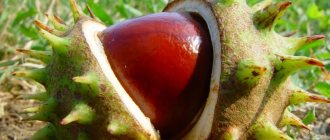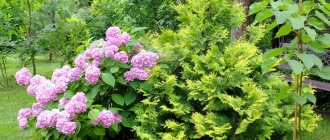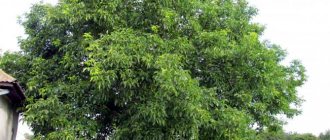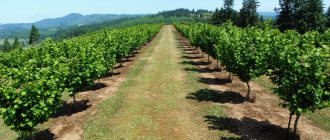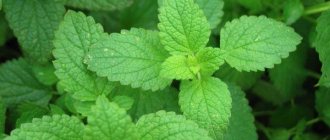- Features of hazelnut propagation
- Growing hazelnuts using nuts
- Selecting a site for planting hazelnuts
- Features of planting hazelnuts in open soil
- Seedling care
- Rules for caring for an adult plant
Hazelnut (hazel) is a perennial shrub plant that reaches 4 m in height. It begins to bear fruit 5 years after planting. Hazelnuts have a large number of beneficial properties. You can plant it in your garden plot: how to grow hazelnuts from a nut, or use layering.
Hazelnuts can be grown from nuts. The main thing is to stick to the rules
Features of hazelnut propagation
Hazel can be propagated in three ways:
- sowing seeds;
- layering;
- root shoots.
For propagation by seeds, the best fruits from the bush are selected and planted in holes, its depth is 4–6 cm, the distance between rows should be 20 cm.
To obtain layering, in the spring, annual branches are placed in shallow ditches and attached to the soil with hooks. The upper part of the branch, 10–15 cm long, is tied to a peg. After the shoots appear, they are subjected to hilling.
Growing hazelnuts by root shoots: in the spring, the shoots are carefully separated from the mother bushes and moved to a new planting site.
Preparation and germination of seed material
Hazel can be propagated in three ways:
- seeds;
- layering;
- dividing the bush.
Hazelnut fruits collected in October must be stratified by cold for three to four months before planting: large whole nuts are placed in water for five days without any damage, then placed in a container with drainage holes and covered with wet sand, peat or sawdust. Keep the container in a cool room at a temperature of 2 to 6 ºC.
During the stratification period, the nuts need to be mixed only once.
- How to plant and care for lilies of the valley
In the photo: Hazel seedling
As soon as sprouts appear, the nuts need to be transplanted into pots. Vessels for future seedlings are selected with the expectation that the plants will have to spend two years in them before they can be transplanted into open ground.
Growing hazelnuts using nuts
One of the popular methods of growing hazelnuts at home is to use seeds. Growing hazelnuts by seed will take more time than when planting seedlings, but there is a high probability that the bush will take root.
The main disadvantage of this planting method is that the first fruits appear only 5 years after planting, and in some situations you will have to wait even longer for the first nuts.
For planting, take whole hazelnut fruits; they should not be damaged by pests. The seeds are placed in water or sprinkled with wet sand. The fruits are left in this position for several days.
For planting, take whole hazelnut fruits that are not damaged by pests.
During this time, the fruits should germinate, after which they are transplanted into pre-prepared pots. The container for the seedling is selected with the expectation that the plant will remain there for two years, after which it is transplanted into open soil.
If you decide to purchase seedlings, then when purchasing them you need to pay attention to the following factors:
- The root system must be well developed. It is better not to buy a plant with dried areas.
- The shoots must be intact; if there are any visible defects, the seedling must be discarded.
- If the buds have already bloomed on the seedling, then it is not recommended to take it, because it may not take root.
Characteristics of hazelnuts: plant characteristics
Hazel, also known as hazelnut, is a well-known shrub that grows preferably on the edges of forests, near rivers and lakes, as well as on mountain slopes. However, as an industrial species, walnut is not very popular in our country and is mainly imported from Georgia, Turkey, and Azerbaijan. But don't think that he is too whimsical.
Growing hazelnuts is not a labor-intensive and not at all complicated process. The shrub is resistant and can grow on any soil, except saline and marshy areas. Many varieties, especially wild ones, take root well and bear fruit even in cool regions.
An adult shrub grows quite large: it can reach up to 5-8 meters in height. It produces many shoots and lives on average more than 40 years. The branches grow vertically and form a dense, wide crown.
Hazel bush in natural conditions
Perhaps the main feature that distinguishes hazel from other hazel trees is that hazelnuts bloom very early. This is one of the earliest plants. In the southern regions it blooms already in February. The latest flowering time is April. As many gardeners say, this is what makes growing bushes difficult, because late frosts often occur in the middle zone.
Fruit
Hazelnuts are a popular nut that is mainly added to chocolate, various nut butters and muesli. The young shrub begins to bear fruit already 3-4 years after planting and gives a good harvest up to 10-15 years. The fruits ripen from August to September depending on the region. The yield, as well as the size of the nuts, depends on the variety and growing conditions. If the hazel is well fed with organic fertilizers and the shoots are cut out in a timely manner, the size of the fruit will increase significantly.
The largest fruits are produced by hybrid varieties. However, they are more capricious to care for and do not tolerate cold well. For the northern regions, simple green hazel is suitable, which can even be taken from the forest.
Hazelnut harvest
Hazelnut fruits are very healthy and contain a large amount of fatty acids and vitamins.
Varieties and types
There are 17 types of hazel, but 3 are considered the main ones:
- common hazel is a very resistant plant that grows in almost all climatic zones: in the Crimea, Karelia, in the southwestern regions and even in Siberia. Lives up to 90 years.
- Pontic species - mainly grown in Abkhazia and is considered the progenitor of many cultivated varieties, including “green” hybrids;
- large hazel - comes from old, cultivated varieties and is the progenitor of Lombard hybrids.
Most of the well-known and popular varieties come from these species. Many of them are grown for decorative purposes due to their unusual, beautiful appearance. For example, the Aurea variety has bright yellow leaves. There are also varieties with hanging and twisting branches.
The best varieties of hazelnuts for growing in the middle zone are considered President, Cherkessky, Futkurama. How to grow hazelnuts in cold regions, told the author of the video channel Ost PressServis.
Selecting a site for planting hazelnuts
To place the plant, a special seat is not required, since it is unpretentious and can get along in any soil and in any climate (with the exception of constant sub-zero temperatures). Planting requires moist soil. If it does not meet the required humidity level, it will need to be watered regularly.
The most suitable soils for hazelnuts:
- gray forest;
- loams;
- sandy loam soils;
- chernozems.
Groundwater located near the place where hazelnuts are planted increases the quality and speed of plant growth. Excess moisture can lead to root rot. The planting site should be well lit, as this directly affects the number of fruits.
The area for planting hazelnuts should not be located in a draft, otherwise there is a risk of disease development. If there is no such territory, then the situation can be corrected with the help of a fence made of slate.
Using slate, you can make a fence to protect the future plant from drafts
How many hazelnut seedlings should there be on the site?
Hazelnuts and hazel are dioecious plants. This means that they have males and females. Nuts ripen on “female” trees, while “male” trees are necessary for pollination and fruiting of “female” trees.
When growing hazelnut seedlings from nuts, you will not be able to determine which trees have sprouted. Therefore, it is necessary to plant at least 3-4 hazelnuts on the site.
Note: to pollinate “female” hazelnuts, they often use undemanding forest “wildlife” - non-flowering male hazel. With low demands on growth conditions, it will be an excellent pollinator for a dozen fruit-bearing “female” hazelnuts.
Features of planting hazelnuts in open soil
Before planting hazelnuts, you need to familiarize yourself with the technology, especially if you are planting a plant grown from seeds.
Hazel has a very short dormant period, so it begins to produce its buds much earlier than other crops. Thanks to this, it can be planted both in spring and autumn, but a small percentage of plants take root in spring.
How to plant hazelnuts:
- Prepare holes measuring 60x60x60 cm.
- Apply fertilizer.
- Clean the roots of the seedlings from the clay mash. If the roots dry out, they need to be placed in water for several days.
- Create a hump in the center of the hole and place the seedling there.
- Fill the seedling so that there is a small hole left for watering.
The hole is filled several times. First, fill it halfway and water it, after absorbing the moisture, fill it with soil a second time and water it again. Planting one young hazelnut bush will require 25 liters of water.
After planting the plant, it is tied to stakes and constantly cut off above five buds. Thanks to regular pruning of the plant, the process of development of fruitful shoots is accelerated. The dimensions of the above-ground part of the plant should be 25 cm.
Features of hazelnut germination
To plant nuts, take raw, unprocessed and unroasted nuts. In order for the collected fruits to sprout, stratification is necessary - a long stay in cold and moisture. Stratification can be natural - if you plant nuts in the ground in the fall. Or it can be artificial - when in January or February the nuts are placed in a damp substrate and placed in the freezer or in the snow outside. The duration of stratification is at least 1 month.
Natural stratification during autumn planting occurs when the top layer of soil freezes in winter. Nuts planted to a depth of 10 cm are kept in moist, frozen soil for several months. By spring they swell and crack.
Growing hazelnuts from nuts at home begins with “home” stratification. It imitates cold and creates the appearance of winter. This triggers the processes of swelling and germination in the nut.
For home stratification, take a container. Fill it with wet sand. Place the nuts in layers. Each layer of nuts is sprinkled with sand so that each nut is surrounded by a moist substrate on all sides.
Cover the container with nuts and wet sand with a lid or polyethylene and put it in the cold (freezer, outside).
To grow hazel from nuts at home, you need to select large, well-ripened fruits. After the seedlings grow from them, further propagation must be carried out vegetatively.
Hazelnuts have male and female flowers. But it cannot pollinate itself because they bloom at different times. In order for pollination to occur and ovaries to appear, 2-3 varieties of hazelnuts should be grown on the site, the flowering of which coincides to pollinate each other.
Seedling care
- The plant requires constant fertilization. You can use rotted leaves, manure or sawdust from trees.
- Applying fertilizer will help accelerate the growth of hazelnuts and the appearance of the first fruitful shoots.
- Stagnation of moisture can lead to rotting of the roots, so the first few weeks after planting seedlings or seeds, the plant is watered constantly, but moderately.
- The first watering of seedlings after planting occurs exactly 7 days later. In the future, hazelnuts need to be watered 1-2 times a week. This allows the planting soil to integrate with the rest of the soil.
- Hazelnuts need cross-pollination to bloom, so several shrubs are planted on the site at once.
- It is required to inspect seedlings weekly for pests.
Hazelnuts and hazelnuts - what's the difference?
From a biological point of view, hazelnuts and hazel are two varieties of the same plant. Common name: hazel or hazelnut. A separate variety of hazel is hazelnut. It is distinguished by larger fruits and nuts and a larger harvest.
When hazelnuts are propagated by planting nuts, not all species characteristics are inherited. Thus, when planting large nuts, only 60% of seedlings will produce large-fruited hazelnuts. 40% will bear fruit with small hazelnuts.
Note: 100% inheritance of species characteristics is guaranteed during vegetative propagation by rooting of branches.
So, growing hazelnuts from nuts has an advantage and a disadvantage. The advantage is the availability of the method. By purchasing just half a cup of nuts, you can get about 10 seedlings. The disadvantage is the unpredictability of the results. You don't know what you'll get. And you will see the size of the nuts on the trees only a few years after planting.
Rules for caring for an adult plant
- The basic rule when caring for an adult shrub is to remove all weak and dried branches.
- For a plant to bear fruit, it must have 8–10 trunks. If there are more of them, they will obscure each other.
- When the plant is 20 years old, it is rejuvenated, all old branches are removed and new ones are left. Such changes should be made gradually, annually removing 2-3 old branches and leaving new ones in their place. If you immediately remove all the old trunks, the plant will stop bearing fruit.
- Mature shrubs need to be fed regularly, since the amount of fruit produced depends on this.
Advice from experienced gardeners
Before you start growing hazelnuts from nuts at home, you should familiarize yourself with the experience of those who have already done this on their site. Here are some tips for successfully cultivating hazelnuts:
- You should not plant wild hazel in your garden - it produces small fruits. But you can use hazelnuts to grow hazelnuts. To do this, a productive hazelnut variety is grafted onto it.
- It is better to plant hazelnuts in autumn. This crop has a short dormant period, so when planted in spring, most of the seedlings do not take root.
- You should not get carried away with fertilizing the soil. Too rich black soil will stimulate the growth of branches and leaves, which will reduce hazelnut yield.
- To successfully control weeds, you can grow some crops under the hazelnut tree, for example, cereals, vegetables, grass.
The advice gardeners share with each other often helps them avoid repeating their mistakes.
Hazelnut propagation at home
Those who like to grow a tree from a nut may well resort to the seed propagation method. It is simple and, if the necessary requirements are met, will allow you to get a strong and healthy plant. However, such hazelnuts will begin to bear fruit much later than the one grown from a seedling. If, when planting a seedling, the first nuts appear 3-4 years after planting, then the plant grown
Growing a hazelnut seedling from a nut
from a nut, bears fruit in 6 or even 10 years.
Therefore, gardeners more often use planting seedlings. With this method of propagation, in contrast to planting a nut, all varietal characteristics of hazelnuts are preserved, based on which a plant suitable for certain conditions is selected.
Selection of seedlings
One- or two-year-old seedlings are selected for planting. It is recommended to give preference to winter-hardy and drought-resistant varieties . Purchasing a seedling from a local nursery guarantees that you will receive zoned varieties adapted to the climatic conditions of the region.
When choosing hazelnut seedlings in a nursery or garden center, you need to carefully examine the root system of the plant. It should be well developed, without damage. Slightly damaged roots are cut out to a healthy place . If there is a lot of damage, you should refuse to purchase a seedling, since severe pruning can affect the survival rate and lead to the death of the plant.
Choosing a landing site
Hazelnut is considered a plant that is unpretentious to the composition of the soil and the terrain. Moderately fertile soil and a sufficient amount of moisture are favorable for the development of the plant and future abundant fruiting. The most suitable for cultivation are gray forest soils, loamy, sandy loam and chernozems of various types. The optimal occurrence of groundwater is no closer than 1.2-1.5 m to the surface . During the spring melting of snow, the area should not be flooded with water - prolonged waterlogging leads to rotting and death of hazelnuts.
However, those whose soil composition is far from ideal should not be upset. Hazelnuts can be safely grown on almost any type of soil characteristic of the middle zone, except for very heavy clay, waterlogged, saline and dry sandy soils. When planting a seedling, chernozems are made easier by adding sand and compost humus - this will improve the air and moisture permeability of the soil . The composition of acidic soils is improved by adding slaked lime, ground chalk or wood ash.
It is best to plant hazelnuts in the fall
Hazelnuts grow equally well on flat areas and mountain slopes. Thanks to its developed fibrous root system, the plant is planted specifically in places where it is necessary to prevent soil erosion. When planting hazelnuts on a plot, you can set aside any place that is not suitable for other garden crops.
Experienced gardeners practice in the first few years planting various garden crops between young hazelnut bushes, which improve the composition of the soil, produce a harvest and do not allow space on the site to become empty.
An important requirement that must be met when choosing a planting site is good lighting. Hazelnuts can also grow in shaded areas, but then you should not hope for a good harvest . Only the presence of a large amount of natural light contributes to abundant fruiting.
When planting on slopes for “cultivated hazel,” you can determine a place on any side except the south. It would seem that the south side is better lit and suitable for a plant that loves light. In fact, in early spring, under bright sunlight, flower buds bloom ahead of schedule, and then die during spring frosts.
The crop is sensitive to draft winds, so when determining a place for planting, choose areas that are as protected from drafts as possible . Building walls or hedges are used as protection from the wind.
When planting several seedlings, the distance between them and the nearest trees with a voluminous crown is maintained at least 4-5 m, depending on the size of the future plant in adulthood.
Landing technology
According to information from gardening reference books, “cultivated hazel” seedlings can be planted in early spring (March-April) or autumn. Hazelnuts have a short dormant period, their buds emerge earlier than other trees, and most of the plants planted in the spring do not take root.
Hazelnut seedling Masterpiece
Gardeners with experience are more inclined to autumn planting - in October-November. The timing for each area is determined individually depending on weather conditions . In any case, autumn planting is carried out a month before the onset of frost.
To get a generous harvest of nuts, at least three bushes of different inter-pollinating hazelnut varieties are planted on the plot.
When planting in autumn, the planting hole for hazelnuts is prepared in the spring ; if planting of the seedling is planned for spring, then preparation is carried out in the fall. This technique allows the soil to rest, freed from weeds, and allow sufficient moisture to accumulate. Life often makes adjustments to our plans, and if the decision to plant hazelnuts came spontaneously, the planting hole can be prepared at least two weeks before planting or immediately before it.
The planting hole is dug with dimensions of 0.6 x 0.6 x 0.6 m. Organic and mineral fertilizers are added to the prepared hole and mixed well with the soil :
- humus - 2-3 buckets;
- double superphosphate – 150-200 g;
- potassium sulfate – 50-70 g.
Following the recommendations for soil preparation will provide the seedling with sufficient nutrition for 3-4 years.
It is more convenient to plant hazelnuts with an assistant: one holds the plant and straightens the root system, the other carries out all the necessary manipulations. The planting technology is simple :
- If the roots of the seedling were treated in a clay mash, wash the clay off the roots . Dipping in mash is only necessary to retain moisture in the roots until planting.
- If the roots of the plant have dried out a little, first immerse them in water for 1-2 days . Drying of the roots is indicated by the wrinkled bark of the shoots.
- If the roots have dried out significantly , then immerse not only them, but the entire seedling in water for 1-2 days until the bark becomes smooth.
- Form a planting mound in the center of the hole and stick a peg into it.
- Place the seedling next to the peg, carefully spread the roots of the plant throughout the hole . The root collar of the seedling should be slightly above the soil level during planting. After watering, the earth will settle and the root collar will be level with the ground. This is very important - if the root collar is buried in the ground, the hazelnut will develop poorly and may not bear fruit at all.
- Fill the hole in two steps . First, fill half of the hole with soil, compact the soil a little and water generously. Then the rest of the hole is filled in, compacted again and watered again. The total amount of water for each seedling is at least 25 liters, optimally depending on weather conditions - 30-40 liters.
- Check the level of the root collar - the maximum permissible excess above ground level is 1-3 cm .
- The seedling is tied to a peg and cut above 5-6 buds . The height of the aboveground part should be 20-25 cm. Pruning promotes the development of several fruitful shoots during the growing season.
Pests and diseases
In the forest, hazel nuts are loved by forest dwellers, such as squirrels, wild boars, mice, and woodpeckers. Hazelnuts growing in summer cottages, of course, rarely have such problems. But caterpillars, beetles, weevils and butterflies can cause significant damage to the hazelnut crop.
Read more
And also hares, which, although rarely, run into the dacha to eat delicious nuts. Walnut weevil and longhorned beetle are the biggest problems for growing walnut bushes. If you do not get rid of them in time, some of the nuts will be irreversibly damaged.
To protect plants from them, it is necessary to take the following measures:
- digging the soil around the bush;
- cleaning wormy nuts;
- shaking off pests onto film and destruction;
- insecticide treatment.
Most often, hazelnuts suffer from powdery mildew, which appears in the second half of summer.
To get rid of it there are the following ways:
- spraying with lime-sulfur decoction;
- treatment with colloidal sulfur.
And of course, to prevent diseases and the appearance of pests, it is necessary to weed the soil under the bushes in a timely manner, water as necessary and remove leaves and mulch before wintering, so as not to leave pests and their larvae under the bushes for the winter.
Care
What care measures need to be provided to hazelnuts so that they grow as a beautiful, healthy and abundantly fruiting tree.
Watering
Hazelnuts love well-moistened soil, but grow poorly in dry soil. During the growing season, the tree should be watered five to six times - very generously. Watering is required:
- after flowering;
- during the formation of ovaries;
- during the formation of future buds;
- after leaf fall.
Water for irrigation should be warm; 40-50 liters should be used per procedure for one adult tree. After watering, you should loosen the soil to make the soil light and permeable. When loosening, we recommend going deeper into the soil by 10-15 cm, no more, so as not to damage the roots of the plant.
Feeding
As already mentioned, during the first three years after planting, hazelnuts do not need to be fed, since enough fertilizer has been placed in the hole. In subsequent years, in the fall, the tree trunk circle is sprinkled with wood ash to speed up the onset of fruiting and increase productivity.
In summer and spring, hazelnuts are fed with the following fertilizers:
- compost/manure;
- humus;
- phosphorus;
- potassium;
- ammonium nitrate.
Trimming
It is best to grow hazelnuts in the form of a spreading bush: the more shoots and branches, the greater the harvest. The ovaries are formed from young shoots, so it is recommended to leave the latter when pruning, cutting only the old ones. The skeleton of the bush is formed from the lower strong 7-10 branches. The distance between the branches left should be approximately equal to those removed: they should not interfere with each other.
During the process of sanitary pruning, it is imperative to get rid of old, diseased and damaged branches. The bush should not be allowed to thicken with obsolete branches, as this significantly reduces the productivity of the fruit plant. Yes, a thickened crown creates a favorable environment for the proliferation of viruses, microbes, and pests often settle in it.
Disease Prevention
To minimize the likelihood of hazelnuts becoming infected with pests and diseases, it is necessary to collect and burn fallen leaves in the fall, and dig up the soil under the nuts in the spring. These measures will help to immediately get rid of many pests that have settled on the leaves and destroy powdery mildew spores.
We learned how to plant hazelnuts at the dacha and how to properly care for them. With the help of the tips given in this article, you can grow a strong and healthy tree that will delight you with a bountiful harvest of delicious nuts every year.
Planting nuts in the ground
Experienced gardeners recommend planting hazelnuts in the fall, although spring planting is not excluded. Since Hazelnut has a short dormant period, when planted in the spring, most of the bushes do not take root. When planting, the depth of the groove in autumn is 8 cm, in spring – 5 cm.
Landing place
Hazelnuts are an unpretentious crop that does not require special soil or a certain terrain. But in order for the plant to be comfortable and to bear fruit well in the future, it is recommended to grow hazelnuts on black soil or loose sandy or loamy soil. It is not advisable to plant Hazelnuts in a wetland, clayey or saline soil.
To ensure that the soil is well permeable to moisture, it is recommended to dilute heavy soils with sand and compost. At high acidity, wood ash or chalk and lime are added to the soil.
After 1-1.5 years, the seedlings will grow to 15 cm in height. From this moment on, they can be transplanted to a permanent place by adding humus.
Attention! Hazelnuts are a “dust-prone” plant, that is, if the garden is planted with only one variety, the harvest is low. Trees should be placed at a distance of about 4 meters from each other.
Is it possible to grow hazelnuts from nuts?
Hazelnuts are not grown on an industrial scale in Russia. Although there is nothing difficult to grow it in the middle zone and southern regions of the country. If you decide to grow hazelnuts from nuts in the country, then you need to know some planting rules and adhere to them.
The peculiarity of such planting is that the harvest of hazelnuts grown from seeds can be harvested not in the 3-5th year, as in trees grown from seedlings, but in the 6th year or later. Varietal characteristics may also not appear in this case. And this must be taken into account. Therefore, the seed method is more often used by breeders to develop new qualities of hazel.
Planting, care
Monarda growing from seeds, planting and care in open ground
In a permanent place, hazelnuts can grow and bear fruit for 100 years. Its valuable, tasty fruits can be enjoyed by several generations of people. Therefore, determining the place to plant hazelnuts must be taken responsibly and competently.
The soil
The nut grows worst on soil with a high acidity content. This can be corrected by treating with lime and regularly adding dolomite flour. Most often it is recommended to apply 0.5 kg per square meter of surface. An important criterion for choosing any type of soil is its fertility, moisture without excessive amounts of water. It is not advisable to plant the plant on slopes facing south. Early awakening of the buds under the influence of spring sunlight leads to damage to female flowers during unexpected spring frosts. How to salt hazelnuts in the country? It is advisable to find a sunny, windless place on the site away from large trees. They do this on slopes that are unsuitable for growing other trees. At the same time, their surface is well strengthened by the root system of the nut, preventing soil erosion.
Landing technology
How to plant hazelnuts? Hazelnuts are often planted in the spring, but the best time to plant seedlings is October. At this time of early autumn it is still warm and the soil is moderately moist. About thirty days before planting, prepare a hole about half a meter deep and wide. It is filled with a mixture that should contain humus, fertilizer, and several handfuls of mycorrhiza. This creates a nutritious environment for the roots, which actively grow in the early years of the nut’s life. A vertical peg is attached to the center of the hole. A seedling is installed nearby, straightening the roots. The level of the root collar is deepened to 4 cm. The neck is not covered. The stem is shortened above the fifth bud. Water and mulch the plantings. Spring planting is possible after the soil has steadily warmed up.
Care
The main requirements for optimal cultivation of hazel are timely watering, removal of weeds, rejuvenation of bushes, crown formation, proper preventive pruning, disease prevention, and pest control. The plant formation procedure is carried out regularly, starting from the third year of life. Eight strong stems are left for the future crown. The remaining trunks are removed at the root. The harvest is planted on new shoots. Fertilizers are applied twice a year. In summer they use ash. Nitrogen fertilizers are used only in early spring. They stimulate growth but reduce yield. The plant is resistant to many diseases and pests. The threat to growth is posed by the larvae of the common cockchafer. One of the tips in the fight against larvae and beetles is to plant white clover and perennial lupine next to the tree. All autumn leaves must be removed, it is better to burn them, destroying the hibernation site of powdery mildew. In the fight against weevils, it is recommended to regularly carry out spring treatment with karbofos.
Hazelnuts are considered a plant for lazy gardeners who do not like to carry out complex agricultural activities. However, a lot of work must be invested in planting and caring for huge industrial hazelnut plantations. Its commercial production is profitable. It has been mastered in Turkey, Italy and other countries. Purchase prices for one kg of nuts fluctuate around $7. And healthy nut butter will always find a market in any quantity.




